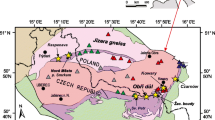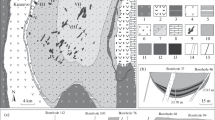Abstract
The Coolac ultramafic belt consists dominantly of variably serpentinised harzburgite and contains a diversity of tectonic inclusions. Reaction zones of chlorite-, talc- and Ca-Al silicate-rich rocks are commonly developed between serpentinites and either tectonic inclusions or country rocks. The chlorite-and talc-rich parts of the reaction zones typically contain sparsely disseminated to rarely massive Cu- and Fe-bearing sulphides, variable sphalerite, and minor Ni- (-Co-Fe) sulphides, arsenides and sulpharsenides, Pb and Bi minerals. The reaction zones have formed concomitantly with the serpentinisation of the harzburgite at temperatures of 100°–350°C and at pressures of <6 kb. Migration of Ca, Al, Ti, V, Sc, Cu and Zn has occurred from the ultramafic rocks to the reaction zones. The sulphur content of the ultramafic rocks increased during serpentinisation, but decreased markedly in the final stage of the process owing possibly to rising oxygen fugacity. The availability of sulphur during serpentinisation may have enabled sulphide minerals to form from the concentration of base metals in the reaction zones.
Zusammenfassung
Der ultrabasische Gürtel von Coolac besteht vorwiegend aus unterschiedlich serpentinisiertem Harzburgit und weist mannigfaltige tektonische Einschlüsse auf. Reaktionszonen Chlorit-, Talk-, und Ca-Al-Silikat-reicher Gesteine sind gewöhnlich entwickelt im Kontaktbereich zwischen serpentinisiertem Harzburgit und entweder tektonischen Einschlüssen oder Gesteinen der Umgebung. Die Chlorit- und Talk-reichen Partien der Reaktionszone enthalten typischerweise fein verteilte, seltene Konzentrationen von Cu- und Feführenden Sulphiden, mit wechselndem Zinkblendegehalt, und untergeordnet Ni(-Co-Fe) Sulphide, Arsenide und Schwefel-haltige Arsenide, sowie Pb-und Bi-haltige Mineralien. Die Reaktionszonen entstanden zusammen mit der Serpentinisierung des Harzburgits bei Temperaturen von 100°–350°C und unter einem Druck von <6 Kb. Migration von Ca, Al, Ti, V, Sc, Cu und Zn verlief von den ultrabasischen Gesteinen zu den Reaktionszonen. Der Schwefelgehalt der ultrabasischen Gesteine nahm während der Serpentinisierung zu, verringerte sich jedoch auffällig im letzten Stadium des Prozesses, möglicherweise wegen der zunehmenden Verflüchtigung des Sauerstoffes. Das Angebot von Schwefel während der Serpentinisierung mag der Grund für die Bildung von Sulphiden aus Schwermetallkonzentration in den Reaktionszonen gewesen sein.
Similar content being viewed by others
References
Antun, P., El Goresy, A., Ramdohr, P.: Ein neuartiger Typ „hydrothermaler“ Cu-Ni Lagerstätten. Mineral. Deposita (Berl.) 1, 113–132 (1966).
Ashley, P. M., Chenhall, B. E., Cremer, P. L., Irving, A. J.: The geology of the Coolac Serpentinite and adjacent rocks east of Tumut, New South Wales. J. Proc. Roy. Soc. N. S. W. 104, 11–29 (1971).
Barnes, I., O'Neil, J. R.: The relationship between fluids in some fresh alpine-type ultramafics and possible modern serpentinisation, western United States. Geol. Soc. Am. Bull. 80, 1947–1960 (1969).
— Rapp, J. B., O'Neil, J. R., Sheppard, R. A., Gude, A. J., III: Metamorphic assemblages and the direction of flow of metamorphic fluids in four instances of serpentinisation. Contr. Mineral. Petrol. 35, 263–276 (1972).
Benson, W. N.: The tectonic conditions accompanying the intrusion of basic and ultrabasic igneous rocks. U.S. Natl. Acad. Sci. Mem. 19, 90pp. (1926).
Černy, P.: Comments on serpentinisation and related metasomatism. Am. Mineralogist 53, 1377–1385 (1968).
Chamberlain, J. A.: Sulfides in the Muskox Intrusion. Can. J. Earth Sci. 4, 105–153 (1967).
— Delabio, R. N.: Mackinawite and valleriite in the Muskox Intrusion. Am. Mineralogist 50, 682–695 (1965).
— McLeod, C. R., Traill, R. J., Lachance, G. R.: Native metals in the Muskox Intrusion. Can. J. Earth Sci. 2, 188–215 (1965).
Coleman, R. G.: New Zealand serpentinites and associated metasomatic rocks. N. Z. Geol. Surv. Bull. 76, 102pp. (1966).
-- Low temperature reaction zones and alpine ultramafic rocks of California, Oregon and Washington. U.S. Geol. Surv. Bull. 1247, 49pp. (1967).
— Plate tectonic emplacement of upper mantle peridotites along continental edges. J. Geophys. Res. 76, 1212–1222 (1971a).
— Petrologic and geophysical nature of serpentinites. Geol. Soc. Am. Bull. 82, 897–917 (1971b).
— Keith, T. E.: A chemical study of serpentinisation — Burro Mountain, California. J. Petrology 12, 311–328 (1971).
Davies, H. L.: Peridotite-gabbro-basalt complex in eastern Papua: an overthrust plate of oceanic mantle and crust. Bur. Miner. Resour. Aust. Bull. 128, 46pp. (1971).
Dewey, J. F., Bird, J. M.: Origin and emplacement of the ophiolite suite: Appalachian ophiolites in Newfoundland. J. Geophys. Res. 76, 3179–3206 (1971).
Engin, T., Hirst, D. M.: Serpentinisation of harzburgites from the alpine peridotite belt of southwest Turkey. Chem. Geol. 6, 281–295 (1970).
Ewers, W. E., Hudson, D. R.: An interpretive study of a nickel-iron sulfide ore intersection, Lunnon Shoot, Kambalda, Western Australia. Econ Geol. 67, 1075–1092 (1972).
Franklin, B.: The North Mooney Complex — a zoned mafic-ultramafic body associated with the Coolac Serpentinite Belt. 44th A. N. Z. A. A. S. Cong., Sydney, Sect. 3 abs., 26 (1972).
Gass, I. G.: The ultrabasic volcanic assemblage of the Troodos Massif, Cyprus. In: Ultramafic and Related Rocks, p. 121–134 (ed. P. J. Wyllie), New York: Wiley 1967.
George, R. J.: Sulphide-silicate reactions during metamorphism of the Nairne pyrite deposit. Proc. Australasian Inst. Mining Met. 230, 1–7 (1969).
Golding, H. G.: The constitution and genesis of the chrome ores in the Coolac Serpentine Belt, New South Wales, Australia. Ph. D. thesis, Univ. New South Wales (unpubl.) (1966).
— The Coolac-Goobarragandra ultramafic belt, N. S. W. J. Proc. Roy. Soc. N. S. W. 102, 173–187 (1969).
Harris, D. C., Vaughan, D. J.: Two fibrous iron sulfides and valleriite from Cyprus with new data on valleriite. Am. Mineralogist 57, 1037–1052 (1972).
Hostetler, P. B., Coleman, R. G., Mumpton, F. A., Evans, B. W.: Brucite in alpine serpentinites. Am. Mineralogist 51, 75–98 (1966).
Jackson, E. D., Thayer, T. P.: Some criteria for distinguishing between stratiform, concentric and alpine peridotite-gabbro complexes. 24th Intern. Geol. Congr., Montreal, Proc. Sec. 2, 289–296 (1972).
Krieger, P., Hagner, A. F.: Gold-nickel mineralisation at Alistos, Sinaloa, Mexico. Am. Mineralogist 28, 257–271 (1943).
Kullerud, G., Yoder, H. S.: Sulfide-silicate reactions. Carnegie Inst. Wash. Yb. 63, 218–222 (1964).
— Sulfide-silicate reactions. Carnegie Inst. Wash. Yb. 64, 192–193 (1965).
Leonardos, O. H., Jr., Fyfe, W. S.: Serpentinites and associated albitites, Mocassin Quadrangle, California. Am. J. Sci. 265, 609–618 (1967).
Mallio, W. J., Gheith, M. A.: Textural and chemical evidence bearing on sulfide-silicate reactions in metasediments. Mineral. Deposita (Berl.) 7, 13–17 (1972).
Milton, C., Milton, D. J.: Nickel-gold ore of the Mackinaw Mine, Snohomish County, Washington, Econ. Geol. 53, 426–447 (1958).
Naldrett, A. J., Gasparrini, E. L.: Archaean nickel sulphide deposits in Canada: their classification, geological setting and genesis with some suggestions as to exploration. Spec. Publs. Geol. Soc. Aust. 3, 201–226 (1971).
Nesbitt, R. W.: The case for liquid immiscibility as a mechanism for nickel sulphide mineralisation in the Eastern Goldfields, Western Australia. Spec. Publs. Geol. Soc. Aust. 3, 253 (1971).
Page, N. J.: Serpentinisation at Burro Mountain, California. Contr. Mineral. Petrol. 14, 321–342 (1967a).
— Serpentinisation considered as a constant volume metasomatic process: a discussion. Am. Mineralogist 52, 545–549 (1967b).
Purvis, A. C., Nesbitt, R. W., Hallberg, J. A.: The geology of part of the Carr Boyd Rocks complex and its associated nickel mineralization, Western Australia. Econ. Geol. 67, 1093–1113 (1972).
Ramdohr, P.: A widespread mineral association connected with serpentinisation. Neues Jahrb. Mineral., Abhandl. 107, 241–265 (1967).
Schlocker, J.: Rodingite from Angel Island, San Francisco Bay, California. U.S. Geol. Surv. Prof. Pap. 400B, B311–B312 (1960).
Shenon, P. J.: A massive sulphide deposit of hydrothermal origin in serpentine. Econ. Geol. 27, 597–613 (1932).
Taylor, H. P., Coleman, R. G.: O18/O16 ratios of coexisting minerals in glaucophane-bearing metamorphic rocks. Geol. Soc. Am. Bull. 79, 1727–1756 (1968).
Thayer, T. P.: Serpentinisation considered as a constant volume metasomatic process. Am. Mineralogist 51, 685–710 (1966).
— Authigenic, polygenic and allogenic ultramafic and gabbroic rocks as hosts for magmatic ore deposits. Spec. Publs. Geol. Soc. Aust. 3, 239–251 (1971).
Vokes, F. M.: A review of the metamorphism of sulphide deposits. Earth-Sci. Rev. 5, 99–143 (1969).
Wenner, D. B., Taylor, H. P., Jr.: Temperatures of serpentinisation of ultramafic rocks based on O18/O16 fractionation between coexisting serpentine and magnetite. Contr. Mineral. Petrol. 32, 165–185 (1971).
Wood, B. L.: Metamorphosed ultramafites and associated formations near Milford Sound, New Zealand. N. Z. J. Geoph. 15, Geol. 88–128 (1972).
Author information
Authors and Affiliations
Rights and permissions
About this article
Cite this article
Ashley, P.M. Petrogenesis of sulphide-bearing reaction zones in the Coolac ultramafic belt, New South Wales, Australia. Mineral. Deposita 8, 370–378 (1973). https://doi.org/10.1007/BF00207518
Received:
Issue Date:
DOI: https://doi.org/10.1007/BF00207518




